It is the process of promoting the interests of followers, by balancing them with those of other stakeholders, to improve and sustain beneficial relationship between them. This perspective of leadership, which is based on the point of view of building relationships, is elucidated by the covenantal model of leadership. This model treats followers’ welfare with utmost respect, and honors the responsibilities of leadership, as expected by the organization.
Comprehension: Framework and Background
The study framework is not presented very clearly:
- Most of the background information is not linked to the study purpose well.
- It over-relies on the findings of previous studies to orient the study, onto the framework.
- The findings of these studies are used to support several points of the research, but do not point directly to the call for action needed to strengthen the study aim. It does not raise the critical problem, which necessitates correlation to be done for all the three factors.
- The failure to build a concise statement of the research problem, out of the provided theoretical framework, leads to a replication of the findings from a previous study; about the relationship of education levels and self-nurturance. The same study is also referred to when building the case to be studied. The findings of the new study should have built on those of the older one, and not replicate them directly in the final stages of the analysis.
In as much as the framework fails to build up a study question or the need for action, it is linked well with the variables that are identified.
- The variables generate data that is useful in quantifying the relationships being studied, and also leads to the findings.
- Substantial reference is made to previous findings, and to some literature on areas of practice being investigated.
From an overall outlook, underlying concepts in theory and evidence-based research are presented sparingly well with dissatisfactions where:
- The literature review does not comprehensively help in focusing the direction of the research.
- Most of the concepts that are used to back up the points of research, are supported with the findings of previous research.
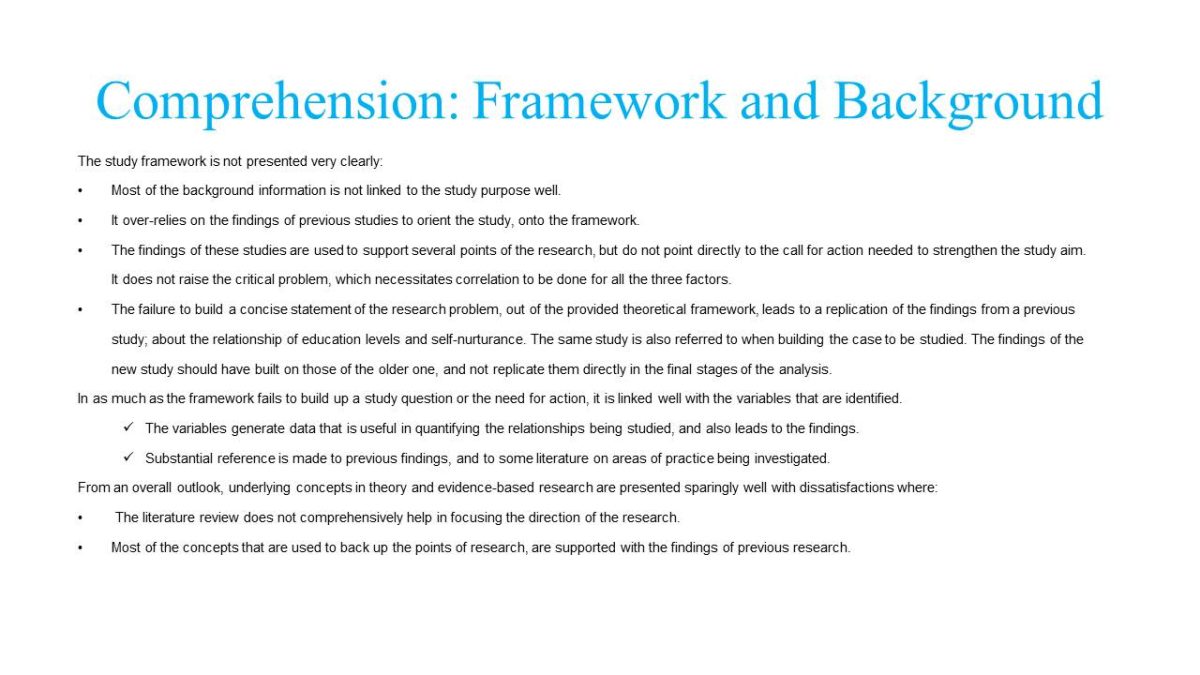
Comprehension: Research problem, objective and purpose, and Comparison: Objective and Study Design
The research problem addresses important issues to do with efficient and proficient practice:
- The welfare of the healthcare giver is of utmost importance to the quality of services that they offer.
- Practitioners who have a greater life and career satisfaction will tend to love their jobs. It is important that they be in good spirits, enough to render services that are above minimal-standards required.
On the other hand, the purpose of the study does not narrow the study aim but only specifies the areas that are to be explored. It aligns them to the existing theoretical framework in the practice of nursing, and draws from the findings of previous studies.
Comparison: Objective and Study Design
The objective of the study, with regard to the correlation among nurturance, magnet factors and life satisfaction, is consistent with the purpose of the study.
In developing the design:
- The study objective and the variables identified for it, necessitate the application of qualitative methods to measure behavior and individual-specific decisions, which are sort for by the study.
- quantitative methods become very crucial in the construction of the data to suit it to the analysis.
This shapes the study design since the objective and nature of data are the key things to consider when selecting a study design (Hudson, 2003).
The design, as a result, is adjusted to suit the objective, by accommodating the employment of multiple strategies, for the varying nature of the variables being handled.
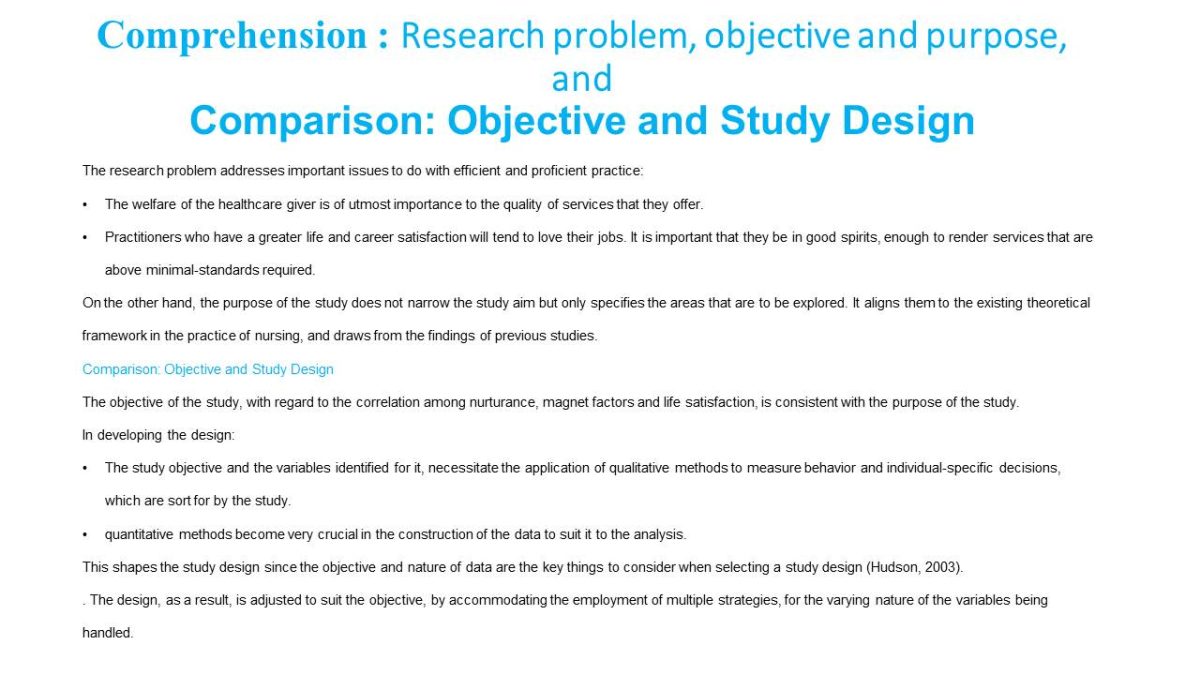
Theory and Methodology: Theoretical and Methodological Limitations
Theoretical limitations:
- The influential variables around the study question are mainly qualitative, hence minimizing the extent to which the researcher can draw from the benefits of quantitative approaches.
- There is no robust research model available in theory, and which would take into account the highly variable nature of the variables.
- The available theory on the factors that make the study question, does not foresee a need to correlate them in a multivariate fashion. These limitations necessitate blending of qualitative and quantitative methods.
Methodological limitations:
- The methodology is adjusted to suit the nature of the parameters being measured for each of the factors.
Mixing of qualitative and quantitative approaches, limits the extent to which either of them can be applied on the variables without making the other one non-viable for the subsequent steps (Hudson, 2003).
Sampling, Variables and Measurements
Sampling:
- The method of sampling used is not robust enough to randomize the study.
- The choosing of participants is subject to the researchers’ judgment, and thus subject to related bias.
- The sample however, is large enough and inclusive of all conceivable diversities within the population. This characteristic to some extent, makes the findings generated from it viable for being generalized to the population (Heo & Leon, 2008).
- The variables generate data that is useful in quantifying the relationships being studied, and also leads to the findings.
- They are defined well and matched to measurable predictors.
Magnet factors: organizational policy, availability of adequate facilities, and favorable workplace environment.
- organizational aspects and policies that are identified to be influential in practice of nursing are not pointed out directly.
Self-nurturance: frequency of engaging in healthy habits, avoidance of self-harm, effort directed towards general self well-being.
Personal satisfaction: Level of contentment with the on-goings in one’s personal life, career, work and compensation.
Application of measured variables to the study objectives:
Each of the variables is investigated independently along the other ones. This approach does not provide a clear measure for the correlation, which is the main aim of the study. Mere co-occurrence of variables may not always translate into direct proportionality as is assumed in this study.
Analysis: Data Analysis and findings
The analysis investigated the trends in the variable predictors for all the variables: SWLS, PEI, career satisfaction, SNS, and healthcare quality.
- It investigates skews in the data, to generate useful relations among the variables, but the correlations are not robust enough to point out a trend across all these variables.
- It does not employ multivariate analyses to identify a correlation that could validate a result that corresponds to either side of the study question.
- It also fails to correctly apply the variables to the analyses, in a way that would give room for possible unidentified influence to be identified: with regard to the extent to which differences in remunerations, and level of education override the effect of self-nurturance, magnet factors and personal satisfaction on the overall performance in shared indicators of good practice.
Ethical behavior in leadership is also demonstrated in development of positive relationships with followers, fellow leaders, and principals. The leader also identifies opportunities, designs strategies to exploit them based on the interests of the stakeholders. He or she shows personal commitment in promoting these interests, and does not do it solely for his or her personal gain.
Image management:
- Leaders need to align their actions with the expectations of the society for them.
- They also need to portray moral uprightness in decisions that they make about contentious issues in the society.
- They also need to grant the rights of stakeholders fairly and based on legitimate values of exchange.
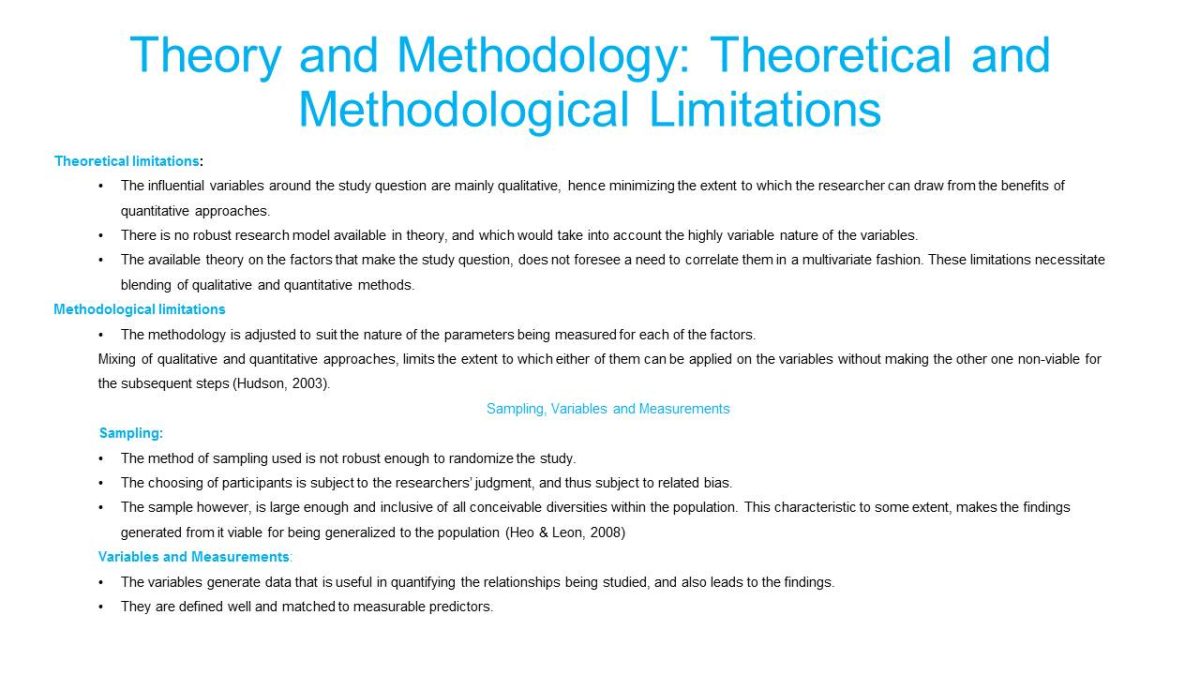
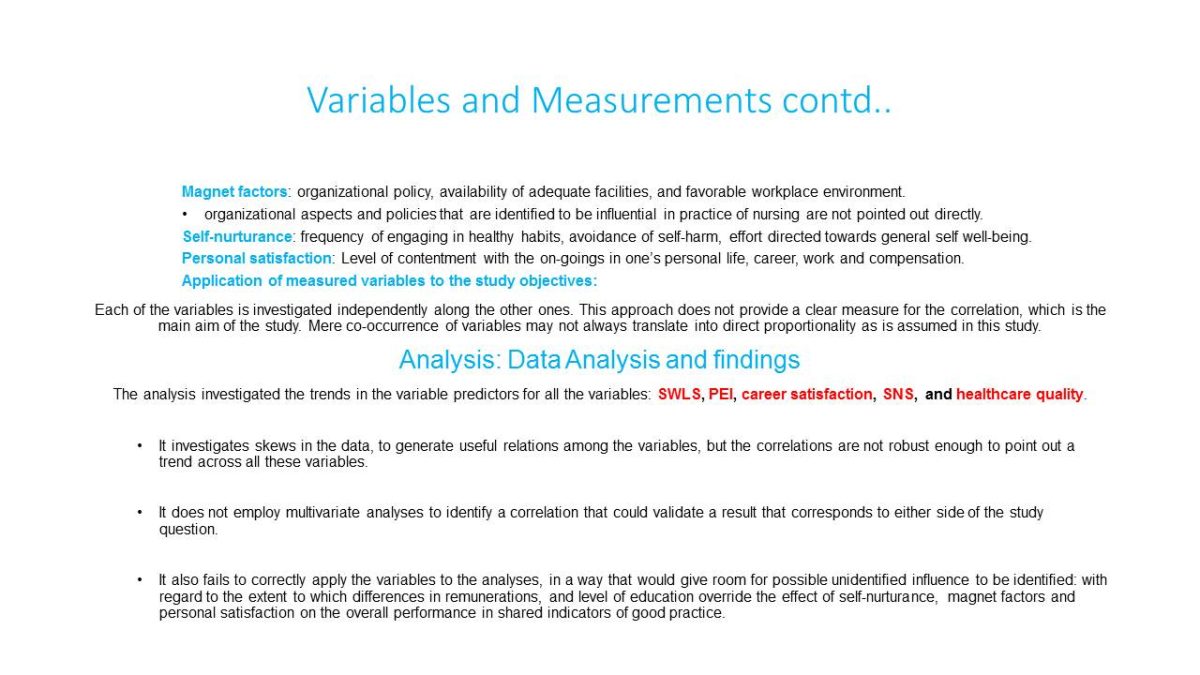
Evaluation: Findings and Bias
Findings: A significant amount of evidence is generated, which emphasizes the need to always improve the welfare of nurses. This improvement will enable them to achieve optimal performance in their practice. It points to essential aspects of professionalism in the practice of nursing.
Bias: There is evidence of researcher bias (which also impacts on findings and their suitability for being generalized to the whole population).
- Generalizing on the impact of variations in the earnings of the RNs on their individual morale and overall happiness.
- The difference in levels of education is an evident source of bias. Ignoring the powerful relationship between this difference and the roles that the nurses play, leads us to ignore the actual nature of each nurse’s duties. This relationship, coupled with the variations in salaries, will more likely than not impact on their level of satisfaction and frequency of self-nurturance. (Heo and Leon, 2008).
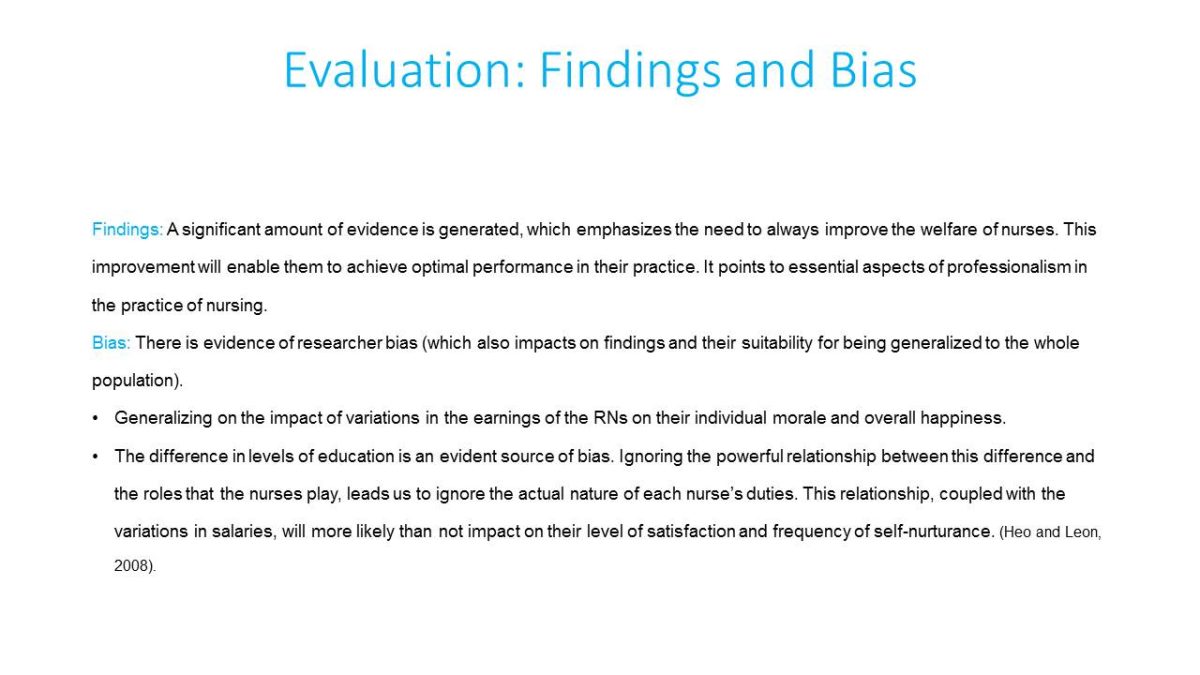
Research Ethics and Legality
The ethical and legal considerations of the research, with regard to protection of the rights of human subjects, are made, and ethical conduct upheld to a large extent such that:
- The whole process adheres to the expected research ethics to a large extent.
- No gross violation of human rights is recorded.
However:
- We are not given full accounts of how participants are handled at each stage.
- The researchers also enforce the roles of data collection to the student nurses quite unfairly. They promise them bonuses in grades, which is a tough condition, and which is quite unfair to those who have to participate in order to avoid missing the bonus mark.
- The generalizations made during the study, as discussed above, and the recommendations made in line with the analysis derived from the affected data, could undermine the rights of a third party (Williamson et al., 2000); patient, administrator or other stakeholder in national healthcare. The level of such a risk is however, subject to the likelihood of the recommendations being adopted into policy or practice without further scrutiny, which is low at the level of national healthcare, but high at the level of those who are directly involved in the study.
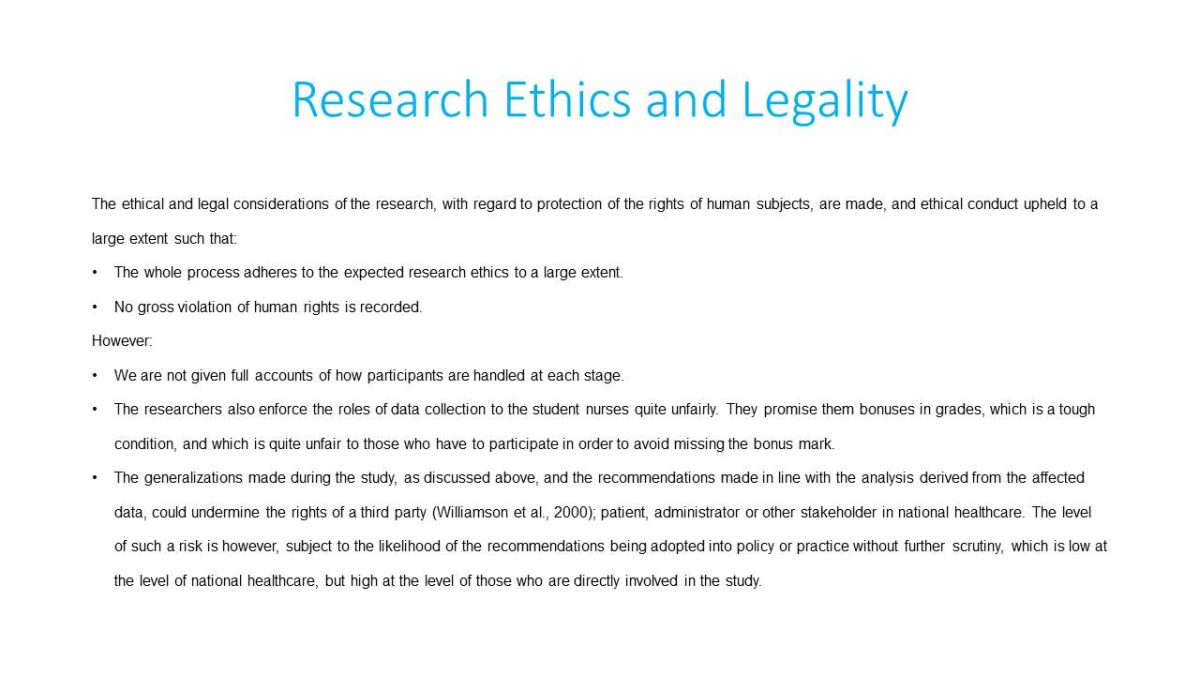
References
Heo, M., & Leon, A.C. (2008). Statistical power and sample size requirements for three level hierarchical cluster randomized trials. Biometrics, 64(4):1256-62.
Hudson, Z. (2003). The research headache—answers to some questions (editorial). Physical Therapy in Sport, 4, 105– 106.
Nemcek, M.A., & James, G.D. (2007). Relationships among the nurse work environment, self-nurturance and life satisfaction. J Adv Nurs.59(3):240-7
Williamson P., Hutton J. L., Bliss J., Blunt, J., Campbell M.J., & Nicholson, R. (2000 February 22). Statistical review by research ethics committees. Journal of the Royal Statistical Society, 1, 5–13.